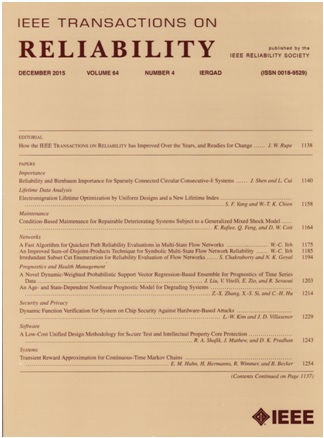加速趋势更新过程的贝叶斯分析及其在锂离子电池数据中的应用
IF 5.7
2区 计算机科学
Q1 COMPUTER SCIENCE, HARDWARE & ARCHITECTURE
引用次数: 0
摘要
在电池可靠性测试期间,在循环充放电过程中反复观察电容、电压或电流等质量特性(QC)值。电池的寿命由QC值低于特定阈值的第一个周期决定。尽管这种循环数据具有周期性,但每次充放电循环的性能都会下降。趋势更新过程(TRP)通过趋势函数对周期性数据进行变换,以确保变换后的数据具有独立和平稳的增量。然而,将趋势函数与更新分布相结合会使所得的似然函数变得复杂。在典型的电池可靠性测试中,样本量很小,电池表现出异质性差异。本文研究了反高斯加速趋势更新过程(ATRP)模型,该模型用于分析各种放电电流下的电池放电容量数据,模型参数在放电电流中为对数线性。三个ATRP随机效应模型采用了层次贝叶斯方法,引入潜在变量来捕获电池之间的单位间变化。基于最大对数边际似然选择最合适的模型,利用马尔可夫链蒙特卡罗方法推导了正常放电电流下的预测寿命推理。蒙特卡罗仿真验证了数值计算结果,并将该方法成功应用于锂离子电池加速退化试验数据。本文章由计算机程序翻译,如有差异,请以英文原文为准。
Bayesian Analysis of Accelerated Trend Renewal Processes With Application to Lithium-Ion Battery Data
During battery reliability tests, quality characteristic (QC) values like capacitance, voltage, or current are repeatedly observed during the cyclic charge-discharge processes. The battery's lifetime is determined by the first cycle where QC values drop below a specific threshold. Despite the recurrent nature of this cyclic data, performance declines with each charge-discharge cycle. The trend renewal process (TRP) transforms this periodic data through a trend function to ensure independent and stationary increments in the transformed data. However, combining the trend function with the renewal distribution complicates the resulting likelihood function. In typical battery reliability tests, sample sizes are small, and batteries exhibit heterogeneous differences. This article examines the inverse Gaussian accelerated trend-renewal process (ATRP) model for analyzing discharge-capacity battery data under various discharge currents, with model parameters being log-linear in discharge current. A hierarchical Bayesian approach is employed for three ATRP random-effects models, introducing latent variables to capture unit-to-unit variation among batteries. By selecting the most appropriate model based on the largest log marginal likelihood, predictive lifetime inference under normal discharging current is derived using the Markov chain Monte Carlo procedure. Monte-Carlo simulations validate the numerical calculations, and the proposed method is successfully applied to lithium-ion battery accelerated degradation test data.
求助全文
通过发布文献求助,成功后即可免费获取论文全文。
去求助
来源期刊

IEEE Transactions on Reliability
工程技术-工程:电子与电气
CiteScore
12.20
自引率
8.50%
发文量
153
审稿时长
7.5 months
期刊介绍:
IEEE Transactions on Reliability is a refereed journal for the reliability and allied disciplines including, but not limited to, maintainability, physics of failure, life testing, prognostics, design and manufacture for reliability, reliability for systems of systems, network availability, mission success, warranty, safety, and various measures of effectiveness. Topics eligible for publication range from hardware to software, from materials to systems, from consumer and industrial devices to manufacturing plants, from individual items to networks, from techniques for making things better to ways of predicting and measuring behavior in the field. As an engineering subject that supports new and existing technologies, we constantly expand into new areas of the assurance sciences.
 求助内容:
求助内容: 应助结果提醒方式:
应助结果提醒方式:


